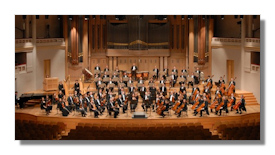
The Internet's Premier Classical Music Source
Related Links
- Latest Reviews
- More Reviews
-
By Composer
-
Collections
DVD & Blu-ray
Books
Concert Reviews
Articles/Interviews
Software
Audio
Search Amazon
Recommended Links
Site News
 Concert Review
Concert Review
Loud, Louder, Loudest

By Marc Haegeman
- Jean Sibelius: The Swan of Tuonela
(from Lemminkäinen Suite, Op. 22/2) - Edvard Grieg: Piano Concerto, Op. 16
- Piotr Ilyitch Tchaikovsky: Symphony #5, Op. 64
Alice Sara Ott, piano
National Orchestra of Belgium/Stefan Blunier
Brussels, Centre for Fine Arts, 23 November 2012
In the Meet & Greet that preceded the performance, Swiss-born conductor Stefan Blunier pointed out how difficult it is to start a concert with Sibelius' Swan of Tuonela. That was unfortunately proven true in this concert with the National Orchestra of Belgium on the next to the last day of the Brussels Bozar Marathon Week. The program was dubbed "Strong musical stories". Strong they may have been, but the stories sounded surprisingly similar in Blunier's hands. Leading a massive orchestra for Sibelius' Swan, Blunier opted for a slow pace but remained more analytical than atmospheric and allowed far too outspoken contrasts and brusque interruptions of orchestral sections (especially brass and bass drum). The cor anglais made a commendable contribution but he was too prominent as if it was his concerto and a swifter tempo would have saved him from some uncomfortable moments. The violins, massed to the left, sounded rather cold, yet the lower strings created an impressive sonority.
Alice Sara Ott offered a refreshing, sensitive performance of the Grieg piano concerto, balancing exciting, if never too ostentatious virtuosity with graceful, natural lyricism. As usual with Ott there was a constant effort to create a harmonious sonority with the orchestra, but here the results were, if not by her doing, uneven. Ott's articulated and colorful piano was often dwarfed by the thick-sounding orchestra, which Blunier let rip into earsplitting, unpleasant outbursts. Orchestral solos were variable and that first horn has to be one of the worst I have heard in a long time. As in the Sibelius the entrances were abrupt and at times imprecise. The Adagio fared better, with Ott's scintillating piano creating strands of delicate yearning, even though here too Blunier's approach remained graphic rather than romantic. The final movement was predictably brought to a thundering end with the brass and timpani clearly determined to blow off the roof. Alice Sara Ott appropriately presented her flowers to the timpanist. Yet, she deserves better.
Maestro Blunier confessed his love for Tchaikovsky's Fifth Symphony at the Meet & Greet, and while that may have been obvious from his commitment on the rostrum, this didn't sound like the right orchestra to demonstrate it. In spite of his serious attempt to sculpt the movements with care, as in the concentrated and emphatic introduction or the well-prepared linking passage to the second theme, once the Allegro con anima got under way insufficient dynamic control obscured the polyphonic writing. There were also issues of orchestral balance that should have been ironed out since this was already the fifth or so performance in a tour with this program. Blunier fielded five horns (Tchaikovsky only wanted four) and they overpowered the two trumpets in the climaxes. As in Grieg the brass sections became blurred during the tutti. The string sections, with the first violins facing the cellos, produced a wall of sound. The array of nuances in the strings was insufficiently emphasized; moreover, while the lower strings continued to make the strongest impact, the violins easily became shrill above the stave. Woodwinds were fine, if without much character. The second movement thankfully featured a different, better focused horn-player, although in tune with the spirit of the evening, he became too loud too soon. Nothing against "loud" if the music requires it (and Tchaikovsky gives us our share), but it's all about how the sound climaxes are achieved. Here they sounded merely gross and out of control, the sort of music-making to give any composer a bad reputation. The quick tempo applied to the Waltz of the third movement came at the expense of precision and elegance, but at least it prevented the drops of tension that occurred in the previous movement. The final movement was, as could be expected, a hysterical orgy of sound, all hell let loose; pretty wild fun, if anything but distinctive. All in all, a disappointingly one-dimensional reading, offering slap-in-your-face power and volume without much of the lyricism and elegance that might hint at the theatrical background in Tchaikovsky's symphonies.
Three magnificent orchestral works; three opportunities to demonstrate the skill and art of an orchestra. It is a shame that Blunier and the Belgian National Orchestra didn't take these opportunities at heart. And hey, if I'm not mistaken Sibelius, Grieg and Tchaikovsky each have an individual sound, don't they?
Copyright © 2012, Marc Haegeman












